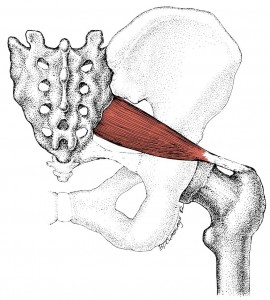Q: What is a piriformis release?
A: The opposite of a piriformis stretch.
A piriformis release refers to releasing chronic tension that might have accumulated in the piriformis muscle that connects the leg to the sacrum.
Only three muscles join the legs to the spine—piriformis, psoas major, and gluteus maximus. These three muscles go a long way to holding the spine on top of the pelvis if we are standing with good skeletal alignment.
Regrettably, they are often overworked or dysfunctional due to poor posture.
I often talk and write about our bones holding us up and the muscles moving us. A number of muscles do more than others when it comes to posture.
The piriformis is among them (as well as psoas major, levator ani…) but when we stand and walk incorrectly the piriformis will be active all the time but in an unfortunate, or ineffective, way.
Poor posture leads to misaligned piriformis and psoas muscles which will suffer and very often become tight and full of tension.
When this is the case release work can be very effective and I will link to several piriformis releases that we work with (Here, here, and here for starters).
The essence of these piriformis releases is that they allow the piriformis to shut off for a while.
Almost everybody tucks the pelvis under and just as many people stand and walk with their feet turned out.
Both of these patterns will shorten the piriformis muscle which doesn’t always mean tight. You can have a short piriformis muscle that is very weak or one that is tight and strong. Every body is different and reacts to postural and muscular imbalances in different ways.
The key is to identify who you are, and what you need, and create a plan to bring positive change to your body. It isn’t necessarily difficult but it is work best performed by you with the help and guidance of others. Get to know your body—especially the piriformis and the psoas. They are as important as it gets when it comes to understanding your core and developing a healthy body.
Does everyone need a piriformis release to get better posture and/or heal pain? Not necessarily but try one of the piriformis releases above and see how it affects you. Even if you aren’t in pain, you might find that your range of motion is freer and movement more fluid.

